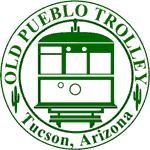Old Pueblo Trolley, Inc.
A part of transit history
Old Pueblo Trolley, Inc.
Electric streetcars began operating in Tucson on June 1, 1906, as a replacement for horse-and-mule-drawn streetcars and for the next 24 years they transported Tucsonans through bustling shopping and residential areas. By 1930, urban growth expanded beyond the University of Arizona and outpaced the ability of streetcars to provide adequate service, so at midnight, December 31, 1930, rail streetcar operation in Tucson ended for good...at least until Old Pueblo Trolley came along.
As part of the 1985 University of Arizona Centennial celebration, a group was founded in early 1983 to bring back the trolley. The dedicated efforts of this small group of people evolved into Old Pueblo Trolley, a nonprofit operating transit museum dedicated to education and the preservation of public transportation history in Tucson and Arizona.
Old Pueblo Trolley's main focus was the operation of historic trolleys from the Fourth Avenue Business District to the main gate of the University of Arizona on Friday nights, Saturdays, and Sundays until the development of the modern streetcar.
These days, OPT does much more than run streetcars. We also collect, restore and maintain historic streetcars and buses, train our volunteer conductors and motormen, publish and display historical research, and support efforts to expand public transportation.
The Southern Arizona Transportation Museum opened as a division of OPT March 20, 2005. This addition to OPT's museum offerings provides visitors with a look at railroading in southern Arizona and the impact on Tucson. The museum also displays , maintains, and continues to improve the condition of retired S.P. Locomotive 1673, mogul M-4 class locomotive. The museum hosts groups of all ages, from the young children to the senior citizens.
It's the work of volunteers and the financial support of members that make all this happen. To find out how you can volunteer, please read about the opportunities we offer -- we need volunteers of all types. If you can help us financially, please join us as a member and see how your membership contributes to our education and preservation efforts.
Tucson public transportation began in 1879 when Bill Morgan started Herdic service. The Herdic, a closed body horse drawn carriage with rear entrance and side seating, ran from downtown to Nine Mile Water Hole, a local stage stop. With the arrival of the Southern Pacific Railroad in 1880, the route was changed to serve the depot on Toole Ave.
Tucson's first street railway was incorporated on September 9, 1897, as Tucson Street Railway. Service to the University began on May 12, 1898. TSR used two types of mule drawn cars, the open type having seats in rows and the closed with Herdic like seating. Each had room for about sixteen passengers and could be driven utilizing a combination of mules or horses.
From 1898 to 1900 TSR ran a line from the Southern Pacific depot to the University of Arizona campus via Congress, Stone and 3rd Streets with a branch line west on Pennington. Service was expanded between 1902 and 1904 to include an extension along the north side of the University of Arizona and additional routes south of downtown including to Elysian Grove which was a 25 acre park noted for its floral displays, amusement park and man made lake.
A 1904 TSR report showed an inventory of seven cars, 8 1/4 miles of track and 34 head of livestock. Horse cars ran in Tucson for eight years and were infamously unreliable, as schedules were seemingly at the mercy of the animals.
Tucson Street Railway became Tucson Rapid Transit Company in June of 1905, a name which would be maintained in Tucson until 1967. TRT purchased five double truck, two man electric streetcars which had originally been used in Los Angeles. Painted yellow, and renumbered 1 to 5 each car could carry thirty passengers with room for standees. After heavier track was laid and overhead wire was strung, Tucson entered the electric streetcar era on June 1, 1906.
In 1915, four new cars, numbered 6 through 9 were purchased from the Wason Manufacturing Co. These were one man single truck cars of light construction, specifically designed for TRT. Each held about twenty people seated on side facing benches reminiscent of the Herdics of 30 years previous. In 1924, three used cars were purchased to supplement the fleet: Number 10, a single truck, one man Birney Safety Car from Douglas, Arizona with a 32 passenger capacity, and Numbers 11 and 12, both single truck Southern Car Company cars from Trinidad, Colorado.
Buses were added to the TRT fleet starting in 1925. Fifteen-minute service was maintained around the University on 6th Street, Campbell and Speedway. In 1930 a petition to have the trolleys replaced by buses was narrowly passed by the City Council and at midnight on December 31, 1930, the streetcar age in Tucson ended as Car Number 10 made its final run.

